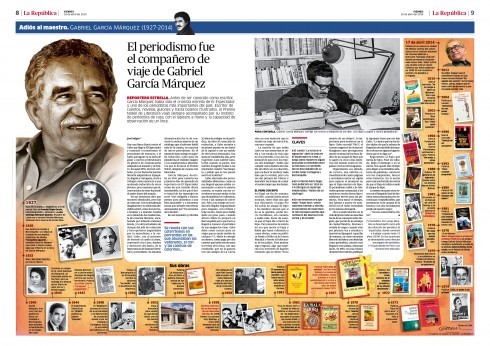This is a special edition of TheMarioBlog paying tribute to Gabriel García Márquez. The next blog post is set for Monday, April 21

I first encountered the magic of Gabriel García Márquez as a senior student at the University of South Florida. We were reading One Hundred Years of Solitude in the original Spanish, and what a rich experience that was. This was not just another required novel we had to read. It was a masterpiece in which the author dealt with the real and the surreal, sometimes within the same sentence. It was also an opportunity to see that love and broken hearts are such a part of the human condition that they don't pay attention to class standing.
When García Márquez died in Mexico Thursday, at age 87, the world quickly gathered to mourn the loss of one of the greatest writers of the 20th Century. “The world mourns Gabo,” read a headline in El Tiempo. Colombia declared a 3-day mourning period to honor one of its most distinguished sons and without a doubt the best known Colombian ever.
I immediately contacted Beiman Pinilla, art director of El Tiempo, for samples and was not at all surprised to see that the national newspaper of the country where García Márquez was born stopped the presses and published an EXTRA edition, something I thought printed newspapers would not do anymore.
Gabo on every front page



La Republica, Peru (courtesy of Ricardo Cervera)
















Soon, art directors of other newspapers were sending their pages as well. Gabo, the Nobel Prize Winner for Literature (1982), made it on a majority of front pages published Friday around the world.
Many of us will retrieve our copies of One Hundred Years of Solitude, Love in the Time of the Cholera or The Autumn of the Patriarch, to re read them and to bask in the language that made García Márquez' prose exquisite to the ear, not just the mind.
A piece in The New York Times describes García Márquez as The Magus of magical realism, a well deserved title for this man from a small town in Colombia–not too different from his fictitious Macondo–whose fertile imagination took us on universal journeys of life and death, love, longing and heartbreak. While his literature is deeply rooted in the Latin America that he loved but probably could not come to terms with, the messages in his works are universal, a reason they are translated to dozens of languages.
Magical realism is all about García Márquez' imaginary, phantasmagorical world, one that we could only access through his words.
When we first encounter the magical realism of García Márquez we are a bit shocked by the fact that the real and surreal coexist so well in the author's mind. Eventually, after 50 pages or so, we have become thoroughly familiarized and fascinated with the magic that García Márquez evokes. By then, we know that in the world of Gabo the extraordinary blends with the ordinary. We begin to get comfortable with the omnipresence of ghosts, or the fact that the matriarch of One Hundred Years of Solitude lives to be 130 years. We witness how the concept of time slips through our fingers the more we advance into any of García Márquez' stories, but particularly One Hundred Years of Solitude. The author is always reminding us that while time moves, the human condition does not seem to be affected by it: we continue to make the same mistakes, generation after generation.
It is as if García Márquez insists on a basic theory that is the foundation of his work: we are going to be born, we are going to love hard, we are going to suffer even harder, and we will die. The cycle will repeat itself, while the ghosts around us may change.
Harold Bloom, a critic, has referred to One Hundred Years of Solitude as a sort of “aesthetic battle fatigue, since every page is rammed full of life beyond the capacity of any single reader to absorb…”.
This is probably true, and one reason why many of us have read that novel more than once. It is a timeless work to be revisited at various stages of our lives, deriving different experiences and reactions each time.
While Gabo has found his eternal solitude, we are happy to have his works to revisit for generations to come.
In Love in the Time of the Cholera, one of the characters said “the only thing that pains me about dying is not to have died of love.”
In the case of Gabo, he has died very much loved.
Of related interest:
Bloom, Harold. Bloom's Critical Interpretations: Edited and with an Introduction by Harold Bloom: “Gabriel García Márquez's One Hundred Years of Solitude”. Philadelphia: Chelsea House Publishers, 2003
Read some García Márquez this weekend:
http://www.vox.com/2014/4/18/5628546/gabriel-garcia-marquez-stories-you-can-read-this-weekend
TheMarioBlog post # 1468